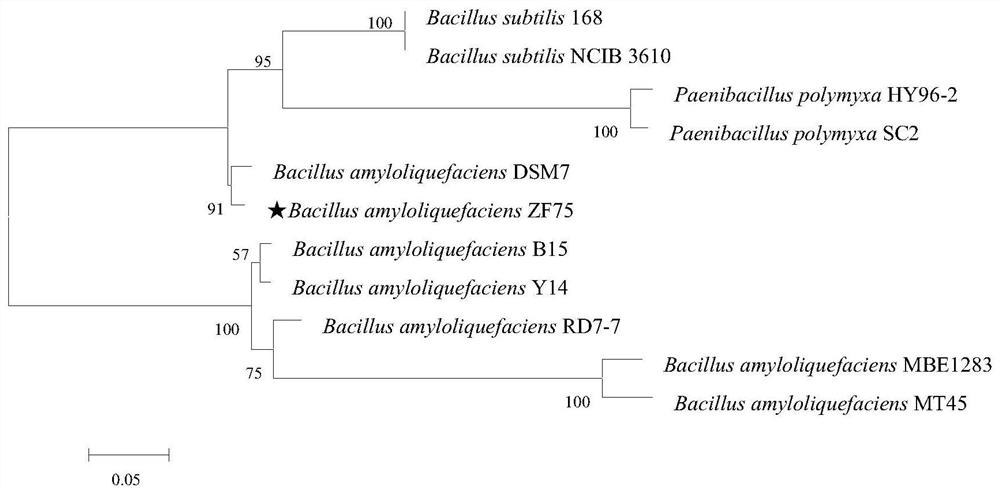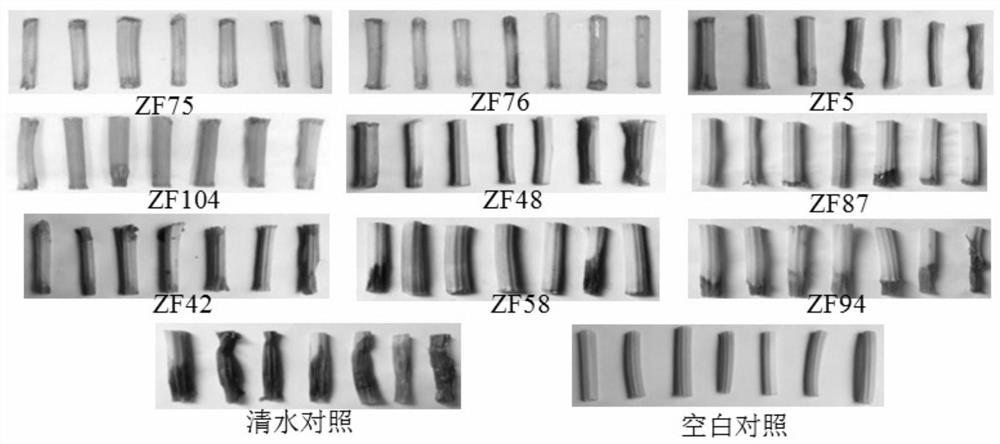A strain of Bacillus amyloliquefaciens and its application in the control of celery soft rot
A technology of amylolytic spores and bacilli, which is applied in the fields of application, pest control, bacteria, etc., can solve the problems of difficult breeding for disease resistance, and achieve the effect of preventing and controlling celery soft rot
- Summary
- Abstract
- Description
- Claims
- Application Information
AI Technical Summary
Problems solved by technology
Method used
Image
Examples
Embodiment 1
[0066] Example 1. Isolation, screening and identification of Bacillus amyloliquefaciens ZF75
[0067] Several strains were isolated from rhizosphere soil collected from greenhouses where celery had been continuously planted for many years in Wuqing District, Tianjin. Pick a single colony and culture it in LB liquid medium to obtain a bacterial suspension; use the celery stem section method to screen out the strains with antibacterial effect on celery soft rot from the above-mentioned selected colonies (see Table 1). Among them, the strain numbered ZF75 has significantly better control effect on celery soft rot than other strains.
[0068] Morphological characteristics of strain ZF75: ZF75 is a Gram-positive bacterium, rod-shaped, endophytic spores, and without flagella.
[0069] Strain ZF75 formed milky white colonies on beef extract peptone medium (LB medium), with folds and irregular edges. figure 1 Colony morphology of strain ZF75.
[0070] The optimal growth temperature...
Embodiment 2
[0076] Embodiment 2, the preparation of bacillus amyloliquefaciens (Bacillus amyloliquefaciens) ZF75 bacterial suspension
[0077] A single colony of purified Bacillus amyloliquefaciens (Bacillus amyloliquefaciens) ZF75 was inoculated in LB liquid medium and cultured at 28° C. at 180 r / min for 2 days to produce a large number of spores of Bacillus amyloliquefaciens. Gained bacterium suspension contains the effective content of described bacillus amyloliquefaciens is 10 7 ~10 9 cfu / mL.
Embodiment 3
[0078] Embodiment 3, simple identification of the inhibitory effect of Bacillus amyloliquefaciens (Bacillus amyloliquefaciens) ZF75 on celery soft rot pathogen
[0079] Pick a single colony of Bacillus amyloliquefaciens (Bacillus amyloliquefaciens) ZF75, inoculate it in LB liquid medium, and culture it with shaking at 28°C for 24 hours for later use. 8 cfu / mL of Bacillus amyloliquefaciens (Bacillus amyloliquefaciens) ZF75 bacterial suspension in a humid box, it is advisable to soak 0.5-1cm stalks in the bacterial suspension. After soaking for 20 minutes, the stems were taken out, placed horizontally and evenly on the filter paper, and air-dried indoors for 1 hour. Then in the same way in the celery soft rot pathogen (carrot soft rot pectin bacillus (Pectobacterium carotovorum)) bacteria suspension (concentration 1 × 10 8 cfu / mL) for 1h. The infection of pathogenic bacteria was observed every 8 hours. When the incidence rate of the water control treatment reached more than 90...
PUM
 Login to View More
Login to View More Abstract
Description
Claims
Application Information
 Login to View More
Login to View More - R&D
- Intellectual Property
- Life Sciences
- Materials
- Tech Scout
- Unparalleled Data Quality
- Higher Quality Content
- 60% Fewer Hallucinations
Browse by: Latest US Patents, China's latest patents, Technical Efficacy Thesaurus, Application Domain, Technology Topic, Popular Technical Reports.
© 2025 PatSnap. All rights reserved.Legal|Privacy policy|Modern Slavery Act Transparency Statement|Sitemap|About US| Contact US: help@patsnap.com



